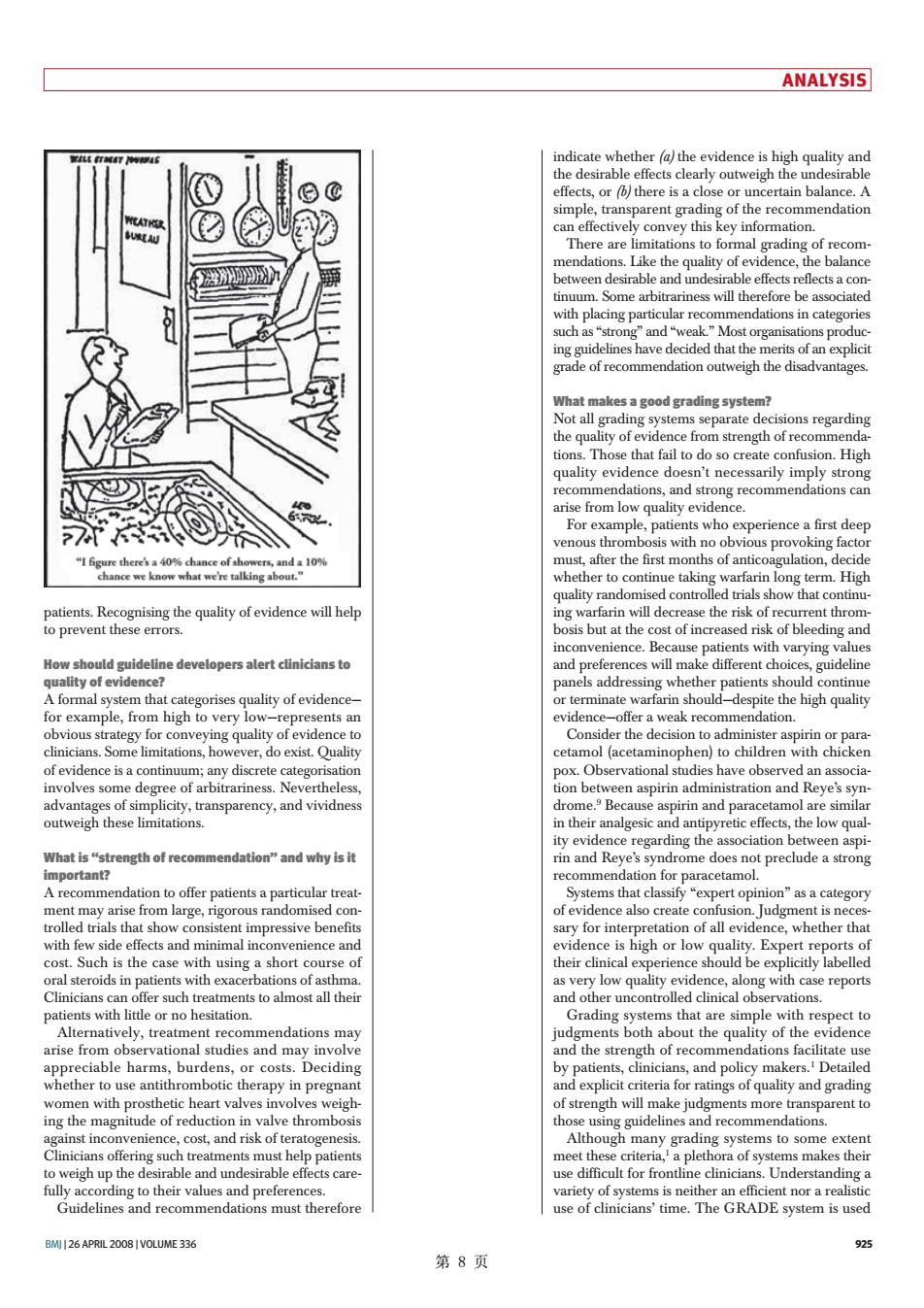正在加载图片...

ANALYSIS indicate whether the evidence is high quality and sto formal grading ofr com and unde h as first dee enous throm whether to con ong term.High nwill decrease the risk ofre ding an A formal s m that categorise aspirin administration and Reye's syn and viv retic effects,the low qual What is "strength of recon endation"and why is it ion Judgm andotherunc ervations atients.cinicians.and polic makers Detailed of quality and grading thos ble ult for fror Guidelines and recommendations must therefore use of clinicians'time.The GRADE system is used BMI126 APRIL 20081VOLUME 336 第8页BMJ | 26 APRIL 2008 | VOLUME 336 925 ANALYSIS indicate whether (a) the evidence is high quality and the desirable effects clearly outweigh the undesirable effects, or (b) there is a close or uncertain balance. A simple, transparent grading of the recommendation can effectively convey this key information. There are limitations to formal grading of recommendations. Like the quality of evidence, the balance between desirable and undesirable effects reflects a continuum. Some arbitrariness will therefore be associated with placing particular recommendations in categories such as “strong” and “weak.” Most organisations producing guidelines have decided that the merits of an explicit grade of recommendation outweigh the disadvantages. What makes a good grading system? Not all grading systems separate decisions regarding the quality of evidence from strength of recommendations. Those that fail to do so create confusion. High quality evidence doesn’t necessarily imply strong recommendations, and strong recommendations can arise from low quality evidence. For example, patients who experience a first deep venous thrombosis with no obvious provoking factor must, after the first months of anticoagulation, decide whether to continue taking warfarin long term. High quality randomised controlled trials show that continuing warfarin will decrease the risk of recurrent thrombosis but at the cost of increased risk of bleeding and inconvenience. Because patients with varying values and preferences will make different choices, guideline panels addressing whether patients should continue or terminate warfarin should—despite the high quality evidence—offer a weak recommendation. Consider the decision to administer aspirin or paracetamol (acetaminophen) to children with chicken pox. Observational studies have observed an association between aspirin administration and Reye’s syndrome.9 Because aspirin and paracetamol are similar in their analgesic and antipyretic effects, the low quality evidence regarding the association between aspirin and Reye’s syndrome does not preclude a strong recommendation for paracetamol. Systems that classify “expert opinion” as a category of evidence also create confusion. Judgment is necessary for interpretation of all evidence, whether that evidence is high or low quality. Expert reports of their clinical experience should be explicitly labelled as very low quality evidence, along with case reports and other uncontrolled clinical observations. Grading systems that are simple with respect to judgments both about the quality of the evidence and the strength of recommendations facilitate use by patients, clinicians, and policy makers.1 Detailed and explicit criteria for ratings of quality and grading of strength will make judgments more transparent to those using guidelines and recommendations. Although many grading systems to some extent meet these criteria,1 a plethora of systems makes their use difficult for frontline clinicians. Understanding a variety of systems is neither an efficient nor a realistic use of clinicians’ time. The GRADE system is used patients. Recognising the quality of evidence will help to prevent these errors. How should guideline developers alert clinicians to quality of evidence? A formal system that categorises quality of evidence— for example, from high to very low—represents an obvious strategy for conveying quality of evidence to clinicians. Some limitations, however, do exist. Quality of evidence is a continuum; any discrete categorisation involves some degree of arbitrariness. Nevertheless, advantages of simplicity, transparency, and vividness outweigh these limitations. What is “strength of recommendation” and why is it important? A recommendation to offer patients a particular treatment may arise from large, rigorous randomised controlled trials that show consistent impressive benefits with few side effects and minimal inconvenience and cost. Such is the case with using a short course of oral steroids in patients with exacerbations of asthma. Clinicians can offer such treatments to almost all their patients with little or no hesitation. Alternatively, treatment recommendations may arise from observational studies and may involve appreciable harms, burdens, or costs. Deciding whether to use antithrombotic therapy in pregnant women with prosthetic heart valves involves weighing the magnitude of reduction in valve thrombosis against inconvenience, cost, and risk of teratogenesis. Clinicians offering such treatments must help patients to weigh up the desirable and undesirable effects carefully according to their values and preferences. Guidelines and recommendations must therefore 第 8 页